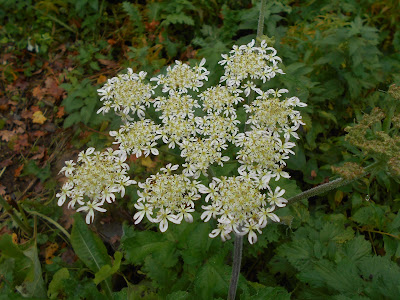With Byfield Pocket Park incredibly wet following prolonged rain I decided to take a break from routine and stroll along the winding road, on either side of which Westhorpe stands.
Clumps of Pellitory of the Wall, Parietaria diffusa, were clustered around the base of several walls and I might have passed by these rather dull plants without a second glance. However I did pause and was rather surprised to see that there were flowers present.
 |
Pellitory of the Wall is very common at the foot of old walls.
Westhorpe Lane, Byfield. 27 November, 2019
|
True they were tiny and lacking any distinctive coloration but at this time of the year any flowers are welcome. This often-neglected species is a member of the Nettle Family, Urticaceae and is often attacked by the insects and fungi which afflict its larger relatives, but these specimens appeared to be largely free of problems. Incidentally, the word pellitory is ultimately derived from the Latin parietis, a wall. Perhaps it has occupied its distinctive location since ancient times. (Another, unrelated plant, Anacyclus pyrethrum, is known as Pellitory of Spain.)
 |
Pellitory of the Wall has flowers which are easily overlooked. Westhorpe,
Byfield. 27 November, 2019 |
In a similar position at the foot of walls were Red Valerian plants, Centranthus ruber. They were being attacked, most obviously by the psyllid bug, Trioza centranthi, which was causing leaf rolls on the edge of foliage. This insect was regarded as rather uncommon up until a few years ago but now many records are coming in: either the insect has become more common or people have been alerted to look out for it.
 |
Trioza centranthi is common locally on Red Valerian.
Westhorpe, Byfield. 27 November, 2019
|
On to Wistaria Cottage. To give the spelling 'Wistaria' to this lovely climber is scientifically wrong and yet it could be argued that this is correct, for was named after Casper Wistar, professor of anatomy at the University of Pennsylvania.
 |
Wrong? Perhaps, but an easy mistake to make.
Westhorpe Lane, Byfield. 27 November, 2019
|
Thomas Nuttall, who named the plant Wisteria seems to have got the spelling wrong but, according to the International Code of Botanical Nomenclature, the original spelling must stand.
Our native Wild Privet, Ligustrum vulgaris, grows along Westhorpe Lane. Privets are members of the Olive Family, Oleaceae, and its small, glossy black fruits do have a passing resemblance to tiny olives. They are still present in some quantity, apparently being eschewed by birds in favour of tastier fare.
 |
Wild Privet, as it is usually unclipped, bears fruit in quantity.
Westhorpe Lane, Byfield. 27 November, 2019.
|
The leaves are distinctive, being almost lanceolate in shape. This make the species easily distinguished when compared to Garden Privet, Ligustrum ovalifolium, some specimens of which also grow along Westhorpe Lane.
 |
| The leaves of our native privet are almost lanceolate. |
This latter species is from Japan and Korea. Its leaves are, as the name indicates, far more oval in shape. Both species are semi-evergreen, managing to retain some of their leaves in even the harshest winters.
 |
Japanese Privet has leaves far more oval in shape. Westhorpe Lane, Byfield.
27 November, 2019
|
Fishbone Cotoneaster, Cotoneaster horizontalis, was in fruit, occupying its usual position against a wall. This Chinese species was introduced to Britain in the late 1870's and can be very invasive, frequently being found in the wild. It does however have two redeeming features: its flowers are very attractive to bees and its fruits are popular winter feed for birds.
 |
Cotoneaster horizontalis is a very popular garden plant. Here it is in
Westhorpe lane, Byfield. 27 November, 2019
|
I will mention only one other plant. The Japanese Quince, Chaenomeles japonica, was displaying its pale yellow apple-like fruit. It is a low-growing shrub, easily confused with C. speciosa, a rather taller plant. (The true quince is Cydonia japonica.)
 |
Japanese Quinces stood out boldly on a miserable, damp day.
Westhorpe, Byfield. 27 November, 2019
|
Theoretically the fruit can be eaten but they are hard and astringent unless allowed to go semi-rotten, a process known as bletting. The books will tell you that it may be used to make quince jelly but I have never found anyone who has attempted this. It is grown instead for its spring flowers which may red, pink or white.
I turned to go home and in so doing lost my footing on a grassy, muddy bank, landing with a bump. 'Oh dearie me!' I muttered...and spent the next few minutes scraping mud from my shoes. However I made my way without further mishap to my car. Foolish man!



































